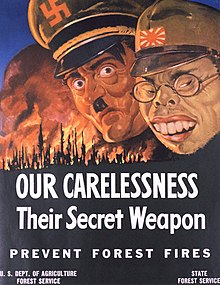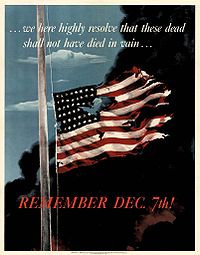Consequences of the attack on Pearl Harbor
The day after the attack, President Franklin D. Roosevelt addressed a joint session of the 77th United States Congress, calling December 7 "a date which will live in infamy".Continuing to intensify its military mobilization, the U.S. government finished converting to a war economy, a process begun by provision of weapons and supplies to the Soviet Union and the British Empire.Some historians, among them Samuel Eliot Morison, believe the attack doomed Imperial Japan to defeat simply because it had awakened the "sleeping giant", regardless of whether the fuel depots or machine shops had been destroyed or even if the carriers had been caught in port and sunk.The closest friend Roosevelt had in the developing Allied alliance, Sir Winston Churchill, stated that his first thought regarding American assistance to the United Kingdom was that "We have won the war,"[11] very soon after Pearl Harbor was attacked.In 1942, Saburō Kurusu, former Japanese ambassador to the United States, gave an address in which he talked about the "historical inevitability of the war of Greater East Asia.Some of the provocations against Japan that he named were the San Francisco School incident, the Naval Limitations Treaty, other unequal treaties, the Nine Power Pact, and constant economic pressure, culminating in the "belligerent" scrap metal and oil embargo in 1941 by the United States and Allied countries to try to contain or reverse the actions of Japan, especially in Indochina, during her expansion of influence and interests throughout Asia.Therefore, according to Kurusu, Japan had no choice but to defend itself and so should rapidly continue to militarize, bring Germany and Italy closer as allies and militarily combat the United States, Britain, and the Netherlands.[19] On December 5, 1941, the Germans learned of the United States Armed Forces' contingency planning to invade Nazi-occupied Continental Europe by 1943; this was Rainbow Five, published by the Chicago Tribune on the previous day.[33] In a speech to the White House Correspondents' Association on U.S. involvement in the war in Europe, Roosevelt stated: ...Nazi forces are not seeking mere modifications in colonial maps or in minor European boundaries.[34]Author Ian Kershaw records Hitler's initial reaction to the attack, when he was first informed about it on the evening of 7 December at Führer Headquarters: "We can't lose the war at all.[36] Hitler awarded Imperial Japanese ambassador to Nazi Germany Hiroshi Ōshima the Grand Cross of the Order of the German Eagle in Gold (1st class) after the attack, praising Japan for striking hard and without first declaring war.[citation needed] Prime Minister Winston Churchill was deeply concerned about the future; he had long attempted to persuade America to enter the war against the Nazis but had been continually rebuffed by American isolationists who argued that the war was purely a European issue and should not be America's concern, and who had prevented Roosevelt from involving the U.S. any further than selling food, weapons and other military materiel, and supplies to the British.Prime Minister Winston Churchill knew that the survival of the British Empire depended on American aid, and since 1940 had frequently asked Roosevelt to declare war."[44] By opening the Pacific War, which ended in the unconditional surrender of Japan, the attack on Pearl Harbor led to the breaking of an Asian check on Soviet expansion.However, in spite of the perceived inevitability of the war by many Japanese, many also believe the Pearl Harbor attack, although a tactical victory, was actually part of a seriously flawed strategy against the U.S. As one columnist wrote, "The Pearl Harbor attack was a brilliant tactic, but part of a strategy based on the belief that a spirit as firm as iron and as beautiful as cherry blossoms could overcome the materially wealthy United States."[47] In 1941, the Japanese Foreign Ministry released a statement saying Japan had intended to make a formal declaration of war to the United States at 1 p.m. Washington time, 25 minutes before the attack at Pearl Harbor was scheduled to begin.[49] The Prime Minister of Japan during World War II, Hideki Tōjō, later wrote, "When reflecting upon it today, that the Pearl Harbor attack should have succeeded in achieving surprise seems a blessing from Heaven.Three days later, with the sinking of Prince of Wales and Repulse off the coast of Malaya, British Prime Minister Winston Churchill exclaimed, "In all the war I never received a more direct shock.These Pearl Harbor veterans were later part of a force that defeated IJN battleships at the Battle of Surigao Strait, an engagement very lopsided in the USN's favor in any case.[63][64] A major flaw of Japanese strategic thinking was a belief that the ultimate Pacific battle would be between battleships of both sides, in keeping with the doctrine of Captain Alfred Mahan.One of the main Japanese objectives was to destroy the three American aircraft carriers stationed in the Pacific, but they were not present: Enterprise was returning from Wake, Lexington from Midway, and Saratoga was under refit at Puget Sound Naval Shipyard.California and West Virginia had an effective torpedo-defense system which held up remarkably well, despite the weight of fire they had to endure, resulting in most of their crews being saved.During active duty, being well protected by escorts and air cover, none of the Pearl Harbor battleships suffered serious damage save for Pennsylvania which was permanently crippled by a torpedo in the closing stages of the war; on September 2, 1945, West Virginia was among the Allied fleet in Tokyo Bay when the Japanese officially surrendered.[67] The carriers Lexington and Enterprise were ferrying additional fighters to American bases on the islands of Wake and Midway while Saratoga was under refit at Puget Sound Naval Shipyard.[69] Nagumo's hesitation, and failure to find and destroy the American carriers, may have been a product of his lack of faith in the attack plan, and of the fact he was a gunnery officer, not an aviator.In addition, Yamamoto's targeting priorities, placing battleships first in importance, reflected an out-of-date Mahanian doctrine, and an inability to extrapolate from history, given the damage German submarines did to British trade in World War I.Because Australian, New Zealand, Dutch and most British forces were in Europe, Japan conquered nearly all of Southeast Asia and the Southwest Pacific, and extended her reach far into the Indian Ocean without significant interference and with nearly universal tactical success.The earlier British raid on Taranto, which is often regarded as the inspiration for the Pearl Harbor attack, achieved its strategic goal being a considerably smaller operation that inflicted much less devastation.[79] Although the US Pacific fleet had five out of eight battleships sunk (three of them permanent losses) at Pearl Harbor, this instead meant a reliance upon the untouched aircraft carriers for offensive operations against the Japanese.[80] The US strikes damaged Truk's dockyards, communications centers, the submarine base, and supply dumps including destroying 17,000 tons of stored fuel, while Pearl Harbor's equivalents were largely untouched in the 1941 attack.











Hideki Tojoattack on Pearl HarborUnited States militaryWorld War IIPacific WarItaly's declaration of warGermany's declaration of warBattle of the AtlanticEuropean theatre of warinterned 120,000 Japanese Americans11,000 German Americans3,000 Italian AmericansneutralNeutrality ActsUnited KingdomGermanywestern statessouthern statesWyomingstate of TennesseeTennessee ValleyNorth AlabamaGeorgiaWestern North CarolinaEastern North CarolinaSouth Carolina LowcountryPee DeeSouth CarolinaUpstate South CarolinaAnglophilicEmpire of JapanUnited States declaration of war on JapanFranklin D. Roosevelt77th United States Congress"a date which will live in infamy"declared war on the Empire of JapanPacifistRepresentativeJeannette RankinRepublicanMontanawar economyprovision of weapons and suppliesSoviet UnionBritish EmpireWest Coastremember Pearl Harbor!U.S. counter-declarationunconditional surrenderSamuel Eliot MorisonPacificEuropean theaterstrade protectionWinston Churchillsabotageespionage by Japanese sympathizerscitizens of Japanese descentJapanese internmentwestern United StatesJohn L. DeWittWestern Defense CommandPacific CoastUnited States Executive Order 9066PropagandaAmerican governmentJapanese declaration of war on the United States and the British EmpireKazuo SakamakiJapan declared war on the United States and the British Empireworld peaceSaburō KurusuSan Francisco School incidentNaval Limitations Treatyunequal treatiesNine Power Pactscrap metalTripartite PactAdolf HitlerGreater East Asia Co-Prosperity SphereHull noteCarrier Striking Task ForceGerman declaration of war against the United StatesItalian declaration of war on the United StatesUnited States declaration of war on Germany (1941)United States declaration of war on ItalyInternment of German AmericansInternment of Italian AmericansGermany–Japan relationsItaly–Japan relationsReichstagYōsuke MatsuokaSoviet–Japanese Neutrality PactGerman–Soviet Nonaggression Pactattack the SovietsNazi GermanyFascist Italywar in EuropeBenito MussoliniLend-LeaseUnited States Armed ForcesNazi-occupied Continental EuropeRainbow FiveChicago TribuneNeutrality PatroldestroyersU-boatsErnest KingErich RaederKriegsmarineSecond Happy TimeOperation BarbarossaEurasiain secret by Japan"new order in Europe"Berlin SportpalastMachtergreifungWhite House Correspondents' Associationelective systems of governmentIan KershawFührer HeadquartersHiroshi ŌshimaGrand Cross of the Order of the German Eagle in GoldUnited Kingdom declaration of war on JapanUnited Kingdom declared war on JapanMalayaSingaporeHong Kong